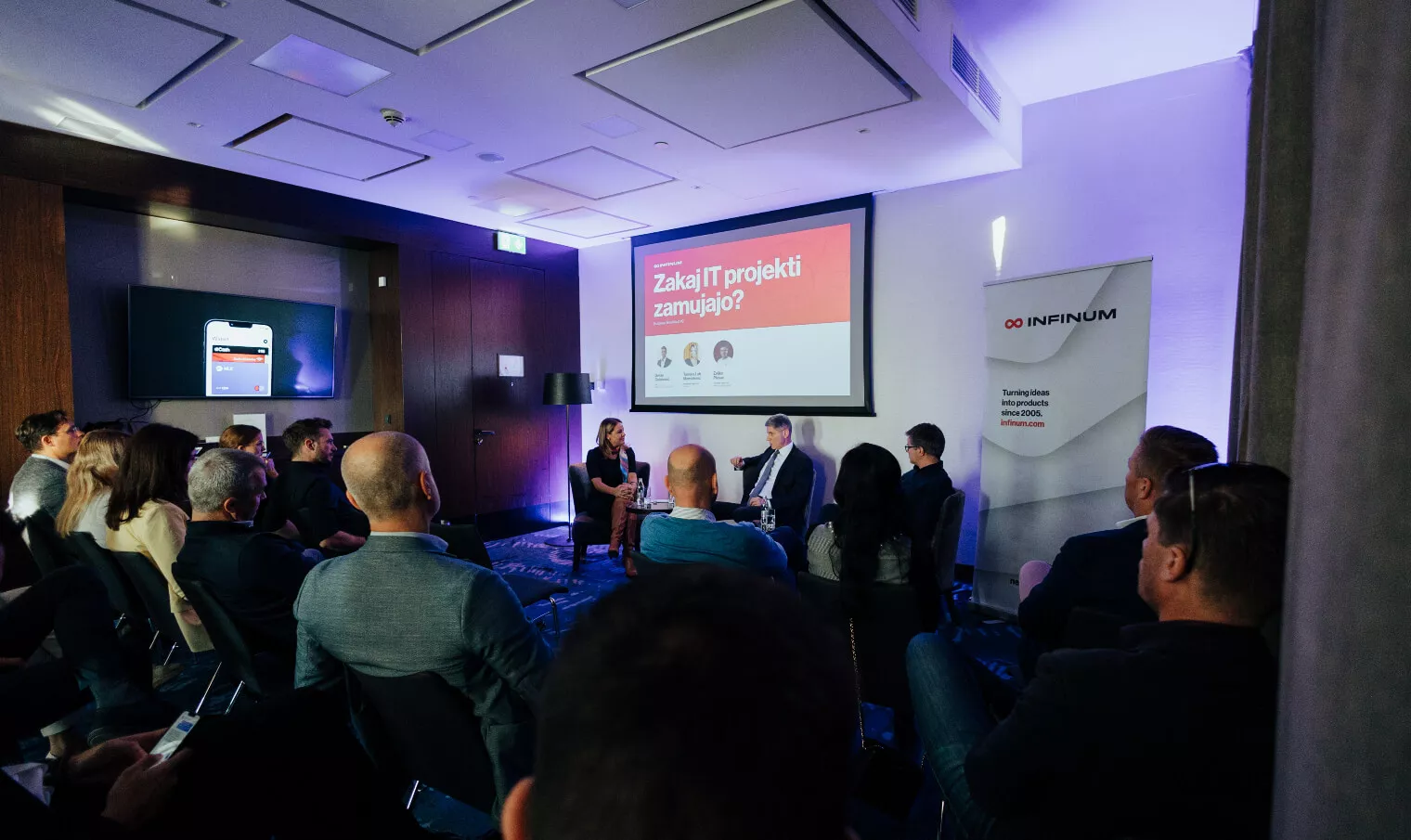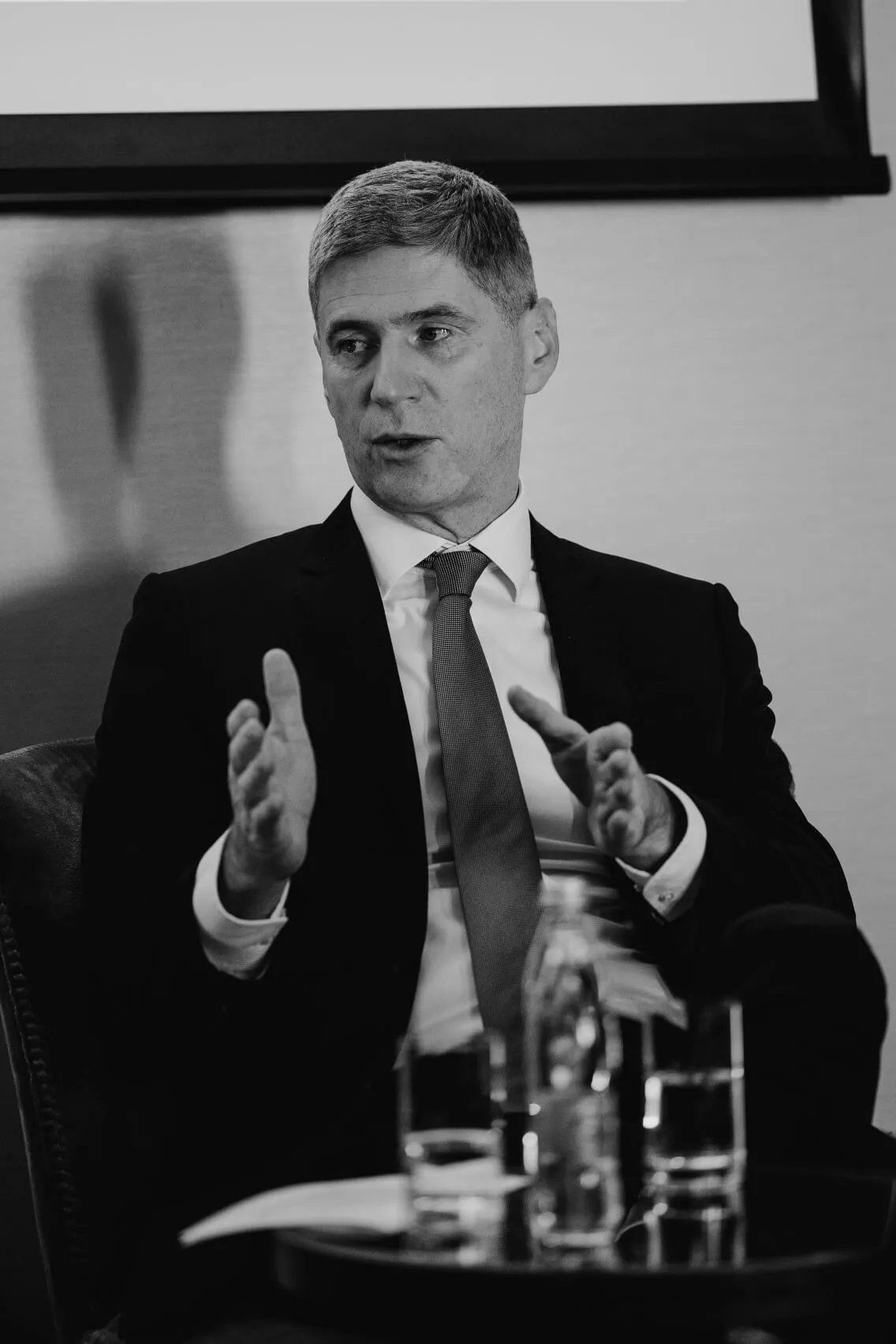The second edition of Infinum Slovenia’s Business Breakfast event identified the main reasons behind project delays. Knowing what to expect, we all become better equipped to tackle potential issues.
Once there’s a product reaping success out in the market, nobody will think much about the hurdles that have been encountered on the way. However, hurdles are more common than you think, and one of the most common ones are project delays.
The phenomenon of software development projects often running late and the reasons behind it were the main focus of the panel discussion held at Infinum Slovenia’s Business Breakfast – a brunch-style networking event for a select group of attendees from the local business community. The idea behind the event is to encourage honest and open discussion on various topics at the intersection of business and technology, even the not-so-comfortable ones.
The main guest of Business Breakfast’s second edition was Goran Golubović, the CIO of Deželna banka Slovenije, a bank with a long tradition and history and a wide network of 76 branches across Slovenia, and the president of the Information Technology Committee of the Bank Association of Slovenia.
Speaking from 25 years of experience in digital transformation projects in the financial sector, Goran identified some of the most common pitfalls that are likely to push a project’s release date far from the client’s original expectations.
Project delays – more common than not
Goran Golubović has worked in managerial roles at a number of banks in the Slovene market and is a professor at the Rome Business School in Belgrade, leading the executive MBA module Managerial Data Science and Advanced Analytics. With a strong background in IT engineering and ample business experience, he was able to provide valuable insights into the subject in question.

“I’ve been involved in a large number of projects, mostly in the banking sector, during the last 25 years. I can say that approximately 80% of them were successful, and the remaining 20% less so. However, all of them experienced at least some delays. I can’t remember that we ever completed a project by the originally set deadline,” reflected Goran, opening the debate.
The lively discussion, in which Goran was joined by Infinum Slovenia’s Managing Director Tamara Lah Momčilović, identified six main reasons that may hinder a project’s progress and lead to unwanted delays.
Company culture can make or break a project
It may not be everyone’s first thought, but corporate culture is key for project success. This includes both sides of the project team, the client as well as the technology partner.
The values and principles nurtured within a company, what we commonly refer to as culture, shape the way a team approaches a project, which then influences its course and the final outcome.
According to Goran, culture is something that is passed top-down and is fundamental for a project to run smoothly.
“If a company has a culture of power play, promotes negativism and career growth by stomping over others, that company will have difficulty completing projects successfully. When the person at the top is positive and values transparency, empathy, and fairness, those are the values that will be promoted on all levels and will increase project pace,” Goran explained.
“It’s the human factor,” Tamara joined in, adding the agency perspective. “Through all the projects we’ve done and the relationships we’ve built, I’ve noticed that on all the successful projects there was almost always a highly positioned individual who understood and knew how to motivate and direct people. If such a person is missing, we have a problem.”
The importance of top-down communication
Another important factor closely connected to culture is quality of communication. Without it, there are no aligned goals and expectations, which will surely hinder a project’s progress.
“This is my lesson learned,” said Goran. “I used to be over-reliant on what my team and I knew that the business part of the company and the management were all on the same page with us and shared our perspective. The reality can be harsh once you realize that this isn’t so.”

There are no IT projects. An isolated IT project could be changing the hardware or network maintenance. Here, we’re talking about business projects that involve the company’s tech teams. The IT department is a partner to the business and supports it in achieving common goals.
GORAN GOLUBOVIĆ, CIO, DEŽELNA BANKA SLOVENIJE
Top-down support is crucial for a successful project. It starts with the management, goes through all the middle layers, and ends with each individual customer. Everyone needs to understand the goals and the benefits, and the only way to achieve company-wide buy-in is effective communication.
Taking on projects in the manner of Chuck Norris
A very common reason likely to bring on delays is an overly ambitious project scope. Very often, the client will try to fit everything they want done in a single project.
Adding features on top of features and trying to tackle everything at once make for an unclear focus. And the more moving targets there are, the bigger the chances for something to go awry.
“If you go into a project like a megalomaniac, set it up like you are Chuck Norris, and want to do all of it at once, you are not likely to succeed. Planning a project that will last over a year is an illusion in this day and age. You need to break it down into smaller, implementable, chewable chunks so that every chunk has some tangible benefit. That way, every month you have a delivery that brings some return on investment, which in turn validates the project,” Goran explained.
Tamara confirmed that this is true from an agency perspective.
“There is no point going into a project with a huge scope and a set deadline. We can tell you right away that this will fail,” she said. “A way to tackle this is for the client to work together with a dedicated team on defining the scope and the next steps. When it’s agreed that we’ll have three or four releases a year, these become our deadlines. Every release has its own scope, and chances are that it will be on the mark.”
When you overpromise, you’re sure to underdeliver
During his career, Goran has worked with a number of technology companies. Unfortunately, not all of them exhibited an impeccable work ethic and dedication. Sometimes he witnessed a substantial discrepancy between what was promised and what was delivered.
“I’ve seen pre-sales teams promise you Hollywood-style dreams, and then the tech teams clutching their heads, unallowed to say anything. You’ll often see these staff members switching companies very soon because they don’t want to participate in what the sales team promised. However, this way you are enhancing the “reliable service providers” filter, you know whom to avoid next time, because at the end of the day, we are working with people, not companies, regardless how big and shiny they are,” Goran shared his experience.
“If you sold something just to sell it, you practically shot yourself in the knees,” Tamara agreed. “It’s completely wrong. If you promise something your teams are unable to deliver, they will leave and you are not going to survive as a company. These things ruin reputations and it’s important to know when to say no.”
Sometimes issues arise from within
A digital product development project, especially in the banking industry, requires the participation of internal teams. However, when these teams don’t have the skillset a modern development project requires, it can cause issues.
“Large corporations often have employees who’ve worked on the same platforms for years. Once you start modernizing and optimizing, they will require upskilling, which is a complex and long-term task,” Goran reflects on his experience. “Maybe one in ten staff members will be enthusiastic and capable enough to make that switch, but all of them are undoubtedly such great diplomats that they will assure you they are willing to learn and master the latest technology, which will not happen in practice.”

What also may prove problematic is the time and focus the staff is able to dedicate to a project. This is especially true with the state of hyper-regulation the industry is currently in, Goran points out.
“There are constant regulatory requirements, stress tests, new ESG regulations. The teams are booked all the time. When there is no adequate resource management, you have a dedicated team made up of people who are all over the place,” he explains.
Goran has experienced this on his own skin, too.
“Once I enthusiastically took on the role of a project manager at a company where I was also the director of several divisions. It’s a huge mistake I’ll never repeat again. You just can’t manage several different roles at the same time, time-wise, physically, mentally, and maintain the same level of quality and the expected delivery“.
Having learned from previous experience, he now has a dedicated, internal project management team working exclusively on the project currently underway. This team can focus on communication, deadlines, or workshops and can easily make sure everything is running smoothly without the dreaded context-switching.
To set up a project, you need to be asking the right questions
Finally, when a project isn’t set up on solid foundations right from the start, it can easily slip into floating specifications, which will surely cause delays. In those situations, the scope keeps eluding and the deadlines become impossible to meet.
“The key thing is asking the right questions. If the business side knows what their challenge is, what they are resolving, and what is the expected delivery, it is a great step towards knowing how to make that happen,” Goran claims.
A great tool for tackling this are discovery workshops, as Tamara pointed out.
“We insist on intense workshops in the early phase so we can try to define as much as we can right from the start. It’s much harder to achieve that later in the process. Communication is also crucial here – later changes in scope can be caused by a misunderstanding between us and the client. If we’ve nearly developed a product and then a feature comes up that should have been connected to a different feature, we’re extending the scope. In come change requests, and the delivery date needs to be moved,” she shares her experience.
Building better products with the lessons learned
As the debate on Infinum Slovenia’s Business Breakfast confirmed, there are a number of things that can go wrong on a digital product development project and cause delays. However, the first step in avoiding them is raising awareness – which is exactly what the event was about.
Goran Golubović has experienced, and navigated, a number of issues on the projects he was involved in. However, he’s also noticing a positive change in how the industry approaches digital projects today.
“We used to work in the waterfall model, set a budget and a fixed scope so we don’t waste time constantly negotiating with an outside partner. Now, I want to talk to that partner all the time. We deliver an MVP in a month or three, get the product to a stage where it is usable, have someone try it out, and then add a couple of features to it. If the product fails to justify the minimal benefit and minimal practical use case in a couple of months, we need to re-evaluate if we need it at all.”
Technology is moving forward at an unprecedented pace, and the general consensus is that large-scope projects and distant deadlines are a thing of the past. Agile methodologies, clear communication, and strong dedication to the project on both sides are the best remedies for aligning expectations and achieving great results.










